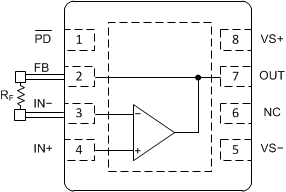ZHCSJO8 May 2019 OPA818
ADVANCE INFORMATION for pre-production products; subject to change without notice.
7.3.2 Feedback Pin
For high speed analog design, minimizing parasitic capacitances and inductances is critical to get the best performance from a high speed amplifier such as the OPA818. Parasitics are especially detrimental in the feedback path and at the inverting input. They result in undesired poles and zeroes in the feedback that could result in reduced phase margin or instability. Techniques used to correct for this phase margin reduction often result in reduced application bandwidth. To keep system engineers from making these tradeoff choices and to simplify the PCB layout, OPA818 features an FB pin on the same side as the inverting input pin, IN–. This allows for a very short feedback resistor, RF, connection between the FB and the IN– pin as shown in Figure 9, thus minimizing parasitics with minimal PCB design effort. Internally the FB pin is connected to VOUT via metal routing on the silicon. Due to the fixed metal sizing of this connection, FB pin has limited current carrying capability and specifications in the Absolute Maximum Ratings must be adhered to for continuous operation.
 Figure 9. RF Connection Between FB and IN– Pins
Figure 9. RF Connection Between FB and IN– Pins